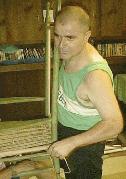In Good Hands
Of the ten children of Roland and Grace Morgan, four have taken up the art of chair caning. Terrence, Lewis, Ronald and Linda rebuild history using natural fibers, talent, patience and their skilled, strong, hands. So beautiful is their work, and so strong is their kinship, that these are the subjects of this story.
With the help of their younger brother, Greg, who runs a furniture repair shop, and their father, Roland Morgan, this foursome restores three to four-hundred chairs each year, weaving seats and backs that will last another lifetime.




Several designs and materials used in chair caning. From left to right: Cane set in a medium weave, Asian Sea Grass in a basket weave, Cane in a straight weave and Binder Cane set in a herringbone weave.
The Morgan home is in an idyll setting, bordered on the back by a peaceful river. Three outbuildings house neatly kept woodshops and furniture waiting to be repaired. The structures are quaint and simple, and are surrounded by heavy landscaping. Leading to the house along the driveway is a split rail fence, worn glass-smooth from years of use as a railing by callused hands. Inside the house is their caning workshop. I take a tour around the shop, watching each of these masters work at their craft.
Terry Morgan finishes work on a rush seat.
Terry and Ronnie are working on the rush seat of a forest green, ladder back chair. Rush is like a thin rope, but is made of paper or fiber from the reedy, rush plant.
In this business, your hands are everything. In soft, deliberate movements, Terry's hands feed the rush around the seat, guiding the weave and keeping it straight. His callused fingers feed the rope - miles of it each week - through holes and around wood, and they knot and twist and pull this rope tight, and they twist and pull it again and again.
Terry keeps a toolbelt on his right hip, with each tool in its own pocket, always within reach. He takes a rush iron - a small, metal prying tool - and works it deftly around the seat, adjusting the rows, tightening the weave and plying the material to fit smoothly.
Ronnie Morgan pauses work on a rush seat
Ronnie pulls a dozen loops of rush through the center of the chair frame before the two men pull them tight. He wraps the rope around cardboard stiffeners, and then, as they tighten each loop, he clamps it with a spring clamp. Slowly, deliberately, they work, and with each pass of the rush, with each bite of the clamp, the hole closes in and, in time, it becomes a seat.
Linda Morgan
Linda stands quietly, weaving a medium cane seat for a small dining chair. There are six grades of cane weaving: Common (the coarsest) Medium, Fine, Fine-fine, Superfine and Carriage Fine. (Most of the chairs the Morgans cane are Common or Medium.)
Working on a diagonal row, Linda guides the cane - a thin strip of the outside of the rattan tree stem - through the seat. Her fingers, thick from years of gripping and threading cane, weave the thin material gently through the rows. She then secures the ends with a wooden peg.
"We soak the cane first," Linda tells me. "It would just break if we didn't. Then, when it dries, it shrinks and becomes tight." She will complete a few more diagonal rows, and this chair, which she has worked on for a couple of days, will be finished.
This is tedious work, and it helps to be patient. When the strain of standing over a chair becomes too much, Linda will sit and knit an afghan. She has made several of these, which their aunt, Evelyn, has raffled off at a local factory.
Lewis Morgan weaves an Asian Sea Grass rope
Lewis works on a beautiful, country rocker, weaving a seat and a back with thin rope made from Asian Sea Grass. When finished, he will have made a comfortable, country-style seat that will support people for generations.
Lewis is halfway through with the seat when he realizes that his pattern does not fit well and he has to undo and redo all his work of the past hour. He must adjust for the fact that the front of the seat is wider then the rear. "I'll try four-and-two," he says after much calculating and discussion with Terry. He isn't upset by this setback, nor by the fact that he couldn't notice it until late in the job.
The siblings have a hurried, hushed way of talking to each other. Working and living under the same roof for decades has built a strong bond between them. So familiar are each others' voices to their ears that they can talk in a manner of shorthand. I can't understand them sometimes and this handicaps me.
The brothers are sports experts. When there is a game on the radio, it is on at the Morgan house and it captures their attention. "We don't disagree much," Lewis says. "But when we do, it's usually about sports." They also agree about sports a lot, about baseball (Red Sox) basketball, hockey, football... whatever is on, they love to listen to it.
Linda doesn't care much for sports. "When they have a game playing, I just leave the room," she says. But she shares their interest in news and music. None of the four enjoy television very much - even the Olympics - as they appreciate the illustrative commentary on radio.
As I say goodbye, I shake the hands of Ronnie, Linda, Lewis and Terry. Each responds with a firm, friendly handshake, and I take this - as my father taught me - as a sign of good character.
Hands guide these brothers and sister because they have to. They guide them through their work, their chores, their exercise and their lives. The quiet house along the Wood River is where they spend most of their time, caning chairs in the shop, taking walks along the driveway fence, exercising and listening to the world on the radio. Without their hands, without their family and without each other, they might just as well be blind.
Read about researching this story in
Where's Mark?
|
Return to our
MAIN page






